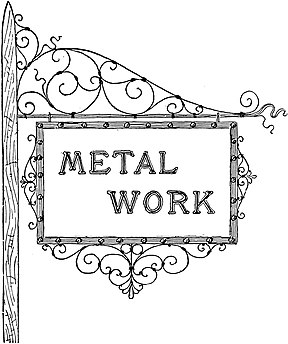During the past few years American and English boys and girls have became so fascinated with Venetian and Florentine metal-work that to-day the materials may be purchased at hardware-stores in many of the large cities.
A few simple designs are shown on these pages, and the instructions given are for the amateurs who are supposed to have had no experience in this kind of work. The tools required will be a pair of flat-nosed and a pair of round-nosed pliers, a pair of heavy shears, and a pair of wire-cutters; a small bench-vise will also be useful.
The materials needed will be a few sheets of thin stovepipe iron of good quality that may be purchased from a tinsmith, several yards of fine, soft iron wire, and some heavy wire for framework.
From the sheets of iron narrow strips are to be cut with the shears, and for ordinary work they should be net more than three sixteenths of an inch in width, but for heavier work the width may be varied. 1f it is possible to obtain the strips at a hardware-store, it will be best to purchase them, as it is a tiresome task to cut many of the strips from sheet-iron; but if they cannot be bought ready-made, it would be best to let a tinsmith cut them with a large pair of shears or gage-cutters. Soft, thin iron that will bend easily is the only kind that is of use, as the hard or brittle iron breaks off, and it is-impossible to bend graceful scrolls of it.
When uniting or binding two strips of metal together, they may be fastened either with wire or bands, as you choose. If the latter mode is employed, short pieces of the metal strips are to be cut
Diagram showing the method of bending and fastening and partly bent in the form of a clamp, as shown in Fig. 5. Bring two sides together and bend one ear of the clamp over them (Fig. 6); and if the other ear is the proper length, bend that down in place, and squeeze all together with the flat-nosed pair of pincers so the perfect joint will appear as shown in Fig. 7.
448

